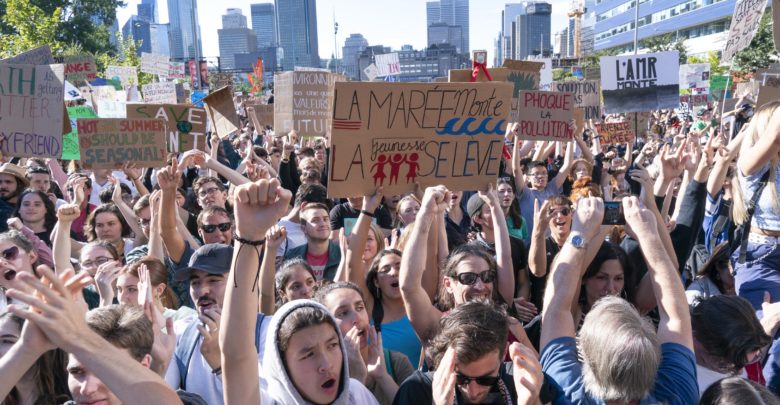
Nearly half a million people demonstrated in Montréal to demand climate action on Sept. 27. It was one of the largest rallies in the city’s history and believed to be the largest of its kind in Canada.
Throngs of people filled the streets around the world, the country and the province. People in Montréal have continued to demonstrate on Tuesdays in support of the climate, banging on pots and pans.
How can we explain the magnitude of these “gestures of political opinion,” as French sociologist Olivier Fillieule calls them, to describe the demonstrations?
There are several possible explanations and some will mention the “Montréal effect.” Only a few years ago, students protesting tuition fee hikes took part in massive demonstrations. Others have taken to the street in the past 50 years over language, sovereignty and the outbreak of the war in Iraq.
But the nature of the climate problem made it easier to mobilize people around this cause than others: climate change is something that concerns everyone. The warm weather that day also encouraged people to walk and helped make global warming a part of the march.

Swedish activist Greta Thunberg participates in the climate march in Montréal on Sept. 27, which brought together some 500,000 people. The Canadian Press/Paul Chiasson
It is, however, necessary to add some context: a thriving civil society exists in Montréal, within the student movement and among secondary school students, environmental and community groups and unions. The mass mobilization of Sept. 27 was clearly the result of long-term work by activists and was in no way “spontaneous.”
However, I would like to propose another explanation here, based on my research on social movements and collective action.
The preferred explanation presupposes links between street mobilizations and the partisan arena; in other words, what happens in Parliament or the Québec national assembly has an effect on what happens in the street, and vice versa.
My suggestion does not invalidate the previous explanations in any way, but rather proposes to take a different look at the Sept. 27 march. It also seeks to understand why the protest was so large, not just why it occurred.
Social movements are here to stay
In political science, political conflicts are expected to occur in the institutional arena, such as Parliament and the legislature. If social movements have a role, it is of whistleblowers proposing “new” issues for public debate, which are then taken up by political parties and elected officials.
It is generally assumed that social movements are “incorporated” into the political system and that they will use the institutional channel to advance their demands. From this perspective, social movements are not considered to be long-term political actors and are not central to the functioning of representative democracy.
That is not my position. I believe that social movements are an integral part of our democracies. They are here to stay. They have a central role to play in “citizen vigilance” and in the political expression of identities and interests. They are, therefore, not an anomaly of our political system, but rather political actors in their own right, playing on the borders of formal institutions.
It is therefore interesting to look at climate mobilizations in relation to the partisan arena.
A fuzzy issue carried by indistinct groups
In the partisan arena (federal or Québec), there does not seem to be a political place for a real politicization of the environmental issue.
The only existing partisan divide separates climate change skeptics and the rest, placing these “others” in an indistinct political mass where their political differences go unheard.
If they were, the debates would also be about the relationship to the capitalist liberal economy and social justice. We would then see fundamental differences emerge between the group of “others,” who would oppose each other on their conception of what our economy should be in order to meet climate challenges, on the intervention expected (or not) from the state, or on the consideration of inequalities in the face of climate change.
In other words, there is no partisan debate on the climate issue at the moment, nor is there any possible debate within the institutional arenas. The political game is therefore played outside, in the street.
In sociology, a political divide is considered to exist if it is carried by political and social forces for a fairly long period of time. This is not the case for environmental issues. They are carried by a myriad of people, networks and organizations — think about it, even the banks closed their doors on the afternoon of Sept. 27. The demands are diverse, often imprecise and refer to a very disparate set of actions that affect the environment.

Justin Trudeau meets with Swedish activist Greta Thunberg in Montréal on Sept. 27. Trudeau, who has the power to make a difference, was one of many demonstrators. The Canadian Press/Ryan Remiorz
Is fighting global warming and making compost really the same battle?
What can we expect in such a situation?
The first possible scenario is the emergence of political mediation, that is a political actor or a party that relays demands from the street to the ballot box. To date, the Green Party of Canada, while growing in popularity, has not played this role on the issue of climate change.
This would not end street protests, but at least not everyone would be seen as on the same side of the fence — or almost on the same side. How can a social movement fully embrace its role as a protester when environment ministers are seen as being at their side? In this context, the question of who or what is the target of mobilization becomes an issue, as well as that of claims or demands.
Another possible scenario: because our system of political representation is not at its best, we can expect to see some radicalization of the protests. As we have yet to see progressive measures or new social rights adopted without people taking to the street, it’s likely that this will be repeated for environmental issues.
We’ve already seen an example of this radicalization. Recently, environmental activists from the global group Extinction Rebellion were arrested after climbing onto the Jacques-Cartier Bridge in Montréal to denounce the “lack of significant action” in the fight against climate change.
Not all will agree that the historic march of Sept. 27 will be, in retrospect, of little political use. However, the question facing those who want to take further action will be how they can best burst onto the public scene by some other means than the parade we attended. We can be encouraged by that or worried about it. That is not really the question here, but there is a high probability that more subversive forms of protest will take place.
Amid all this, we are near the end of an election campaign. Let us remember that the political parties have a very important role to play in how these massive climate protests are translated into action. They don’t seem to grasp that.
Artikel ini telah tayang di theconversation.com dengan judul “A monster rally for climate change, but divergent goals hinder the fight”, https://theconversation.com/a-monster-rally-for-climate-change-but-divergent-goals-hinder-the-fight-125358
Penulis : Professeure titulaire – spécialiste des mouvements sociaux et de l’action collective, Université de Montréal
Foto Cover : Demonstrators take part in the climate march on Sept. 27 in Montréal. Paul Chiasson/The Canadian Press



